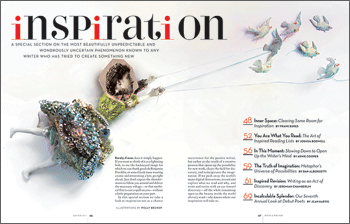Poets & Writers Magazine welcomes feedback from its readers. Please post a comment on select articles at www.pw.org/magazine, e-mail editor@pw.org, or write to Editor, Poets & Writers Magazine, 90 Broad Street, Suite 2100, New York, NY 10004. Letters accepted for publication may be edited for clarity and length.
 The Right Stuff
The Right Stuff
I’ve been a subscriber and devoted reader for many years, but the January/February 2012 Inspiration Issue was my favorite of all time. The cover was elegantly refreshing, like walking through a garden of freshly fallen snow. Christopher Wall’s article “Naming the World: The Anxiety of Finding the Right Word” was smart, funny, and articulate. “Why We Write: The Landscape of What Remains” by fellow Portlander Melissa Madenski was heartbreaking and intimate. Finally, thanks to Frank Bures’s “Inner Space: Clearing Some Room for Inspiration,” I now have a name for what ails me as a writer in the modern age: “continuous partial attention.” Bravo for a great issue, offering such a fine collection of essays on the stuff I find interesting.
Diane Prokop
Portland, Oregon
Ampersand Appeal
I loved Kevin Nance’s article “Poets & Ampersands” (January/February 2012), being pretty wild about ampersands myself. I was never sure I was normal, but now I realize what a shared pleasure & is. I was glad to have it articulated.
Joan Logghe
Espanola, New Mexico
I think Nance makes as strong a case as can be made for the ampersand. I just wonder if the poets using it realize they are using Latin rather than English. I suppose if poems came to us always handwritten, I could understand the usage, as a time-saver. But we read poems when they are in print. And when the poem is read aloud, you can’t hear the ampersand. So if it’s an essential part of the meaning of the poem, the poet should signal visually every time it appears on the page. Granted, that would be a distracting affectation. And why don’t those who use it also use “w/” for “with” and “w/o” for “without”? Are you next going to publish an article about poets who write without uppercase letters, including for the first-person singular pronoun? It’s something else I find distracting, though, again, many people like it.
Excerpted from a comment posted onpw.org/magazine by 5728
A Guide to Going Long
I was walking and leafing through the January/February 2012 issue when John Stazinski’s article “A Novel Approach: Learning to Write More Than Stories” stopped me midstride. I ended up reading most of it standing up. I’ve been struggling through a serious case of novel-panic—it’s not the first time I’ve experienced it, but it’s the closest I’ve ever come to giving up. I received an MFA some years ago, and I’ve had a fine career writing and editing in the business world. But when, in an effort to get back to my fiction roots a few years ago, I picked up a novel I’d started to write in grad school, I was shocked by how ill prepared I was for the rigors of writing a book-length piece of fiction. Like Stazinski, I have gone through dozens of self-help books looking for guidance. I, too, was dumbfounded by the notion that you could write a novel simply by turning out a certain number of pages a day. What about the intricacies of theme, style, and character growth? Not to mention the process of developing a story idea that would engage the reader—and writer—for the length of a novel. Don’t get me wrong—I loved my time in grad school, but I found myself wishing we’d had a class or two on plotting a novel or developing bookworthy characters. A yearlong course devoted to workshopping a novel would have been bliss. After reading the article, I went to my bookshelf and found both of the John Gardner classics Stazinski suggests, The Art of Fiction and On Becoming a Novelist. I’m grateful to Stazinski for directing me to them and for giving me the strength to try again.
Terri Huck
Sterling, Virginia







